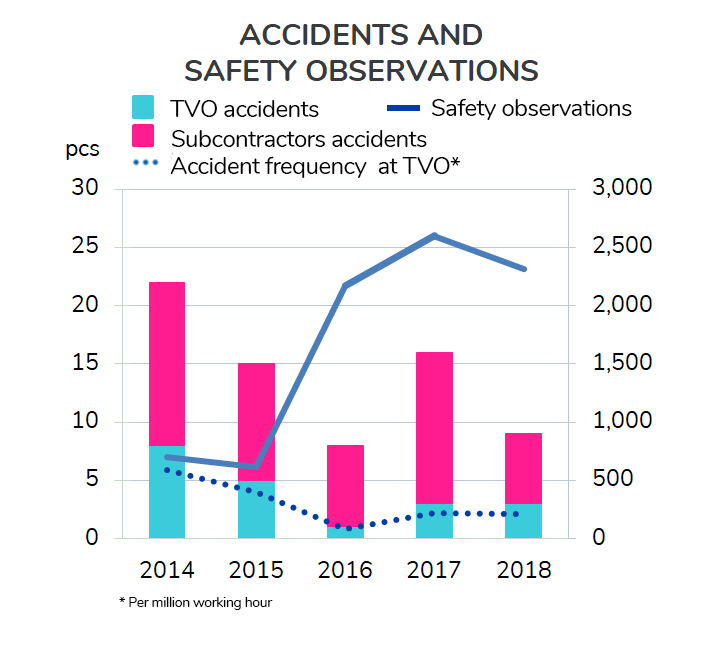- Responsibility
-
Responsible leadership


-
Social opinion leader


-
Responsible procurement operations


-
Research and development
-
Safety


-
Good work community


-
Shareholder value


-
Supply of electricity in Finland and climate impact


-
TVO as a company
-
Environment and climate
-
Environmental management
-
Environmental program 2019–2021
-
Results of the environmental program
-
Climate-friendly electricity
-
Environmental impacts
-
Cooling water
-
Raw materials and material efficiency
-
Production and energy efficiency
-
Emissions to the air
-
Emissions to water and soil
-
Waste
-
Environmental research and biodiversity
-
Cooperation with the authorities
-
Nuclear waste management
-
-
Responsibility reporting


- Governance
-
General
-
Shareholders' meeting
-
Board of Directors
-
Board committees
-
Committees and steering groups assisting the management
-
President and CEO
-
Management Group
-
Auditor
-
Remuneration
-
Insider administration
-
Disclosure policy for investors
-
Internal control and risk management


-
TVO Board of Directors in 2018
-
TVO Management Group in 2018
-
Organization
-
- Report of the Board of Directors
-
Main events in 2018
-
Operating environment
-
TVO as a company
-
Financial performance
-
Financing and liquidity
-
Share capital
-
Administrative principles
-
Administrative bodies
-
Regulatory environment
-
Risk management, major risks and uncertainties
-
Pending court cases and disputes
-
Nuclear power


-
Coal power


-
Research and development
-
Acquisitions of tangible and intangible assets and shares
-
Responsibility


-
Group personnel and training
-
Subsidiaries and joint ventures
-
Major events after the end of the year
-
Prospects for the future
-
Proposals to the Annual General Meeting
-
- Financial Statements
-
Key figures of TVO Group
-
Key figures of Teollisuuden Voima Oyj
-
TVO Group financial statements


-
Consolidated income statement
-
Consolidated statement of comprehensive income
-
Consolidated balance sheet
-
Consolidated statement of changes in total equity
-
Consolidated cash flow statement
-
Notes to the consolidated financial statements


- 1 General information on the Group
- 2 Accounting policies
- 3 Segment reporting
- 4 Work performed for own purpose
- 5 Other income
- 6 Materials and services
- 7 Personnel expenses
- 8 Depreciation and impairment charges
- 9 Other expenses
- 10 Finance income and expenses
- 11 Income tax expense
- 12 Property, plant and equipment
- 13 Intangible assets
- 14 Investments in joint ventures
- 15 Book values of financial assets and liabilities by categories
- 16 Loans and other receivables
- 17 Investment in shares
- 18 Cash and cash equivalents
- 19 Inventories
- 20 Derivative financial instruments
- 21 Equity
- 22 Interest-bearing liabilities
- 23 Trade payables and other current liabilities
- 24 Assets and provision related to nuclear waste management obligation
- 25 Obligations and other commitments
- 26 Related party
- 27 Financial risk management
- 28 Changes in accounting principles
- 29 Events after the balance sheet date
-
-
Parent company's financial statements


-
Parent company's income statement
-
Parent company's balance sheet
-
Parent company's cash flow statement
-
Notes to the parent company's financial statements


- 1 Accounting principles
- 2 Turnover
- 3 Work performed for own purpose
- 4 Other income
- 5 Materials and services
- 6 Notes concerning personnel and members of administrative bodies
- 7 Depreciation and impairment charges
- 8 Other expenses
- 9 Financial income and expenses
- 10 Appropriations
- 11 Non-current assets
- 12 Investments
- 13 Inventories
- 14 Current receivables
- 15 Equity
- 16 Distributable equity
- 17 Non-current liabilities
- 18 Debts due in more than five years
- 19 Current liabilities
- 20 Commitments
- 21 Derivative financial instruments
- 22 Series of shares
- 23 Carbon dioxide emission rights
-
-
Proposals to the Annual General Meeting
-
Signatures for the report of the Board of Directors and financial statements
-
Auditor's report
-
Financial information in 2019
-
Parent company's financial statements
 The combined accident frequency at Olkiluoto was 3.6. This figure includes TVO’s employees, Posiva’s employees and the employees of all the subcontractors who worked at Olkiluoto, excluding the OL3 construction site, the statistics of which are reported by the AREVA-Siemens consortium.
The combined accident frequency at Olkiluoto was 3.6. This figure includes TVO’s employees, Posiva’s employees and the employees of all the subcontractors who worked at Olkiluoto, excluding the OL3 construction site, the statistics of which are reported by the AREVA-Siemens consortium.




